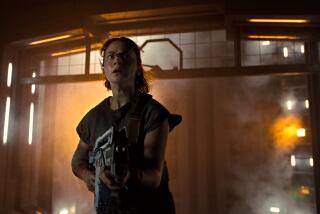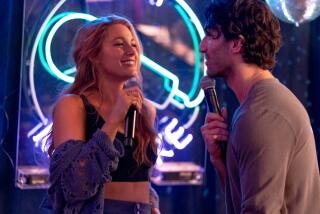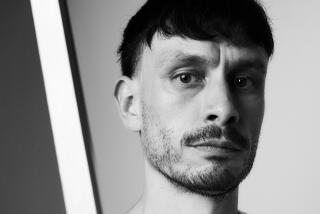Inside 2020’s most anticipated — and targeted — game: violence, a virus, an LGBTQ love story
Halley Gross wanted to be a comedian. The former child actress set her sights on stand-up as she entered adulthood, hoping when she began college to model her career after that of Tina Fey.
One problem: Comedy made her uncomfortable. What she craved was something more … depraved.
Dreams, it turns out, can come true.
After serving as a writer and story editor for several episodes of HBO’s “Westworld,” she’s emerged as the narrative lead and co-writer for the most anticipated game of 2020: “The Last of Us Part II.” It will also be one of the year’s most argued-over games.
Coming Friday to Sony’s PlayStation 4, the “Last of Us” sequel challenges audiences with a mature, often tough-to-stomach narrative about the contradictions and complexities of life under duress — and an America ravaged by an uncontrollable virus. At no point does it try to comfort.
The quest for a cure becomes intermingled with destructive human desires for power and personal gratification, leaving what passes for wealth to the few. The rest? They get fear — they’re lucky if they can score a virus-protecting face mask.
With two LGBTQ anti-heroes at the heart of the game, the game’s themes touch on faith, sexuality and militarization and zero in on the struggle to maintain a sense of self. Or, more damning, how the latter is often misinformed by our country’s habit of erecting prejudicial boundaries.
Some of these boundaries have made “The Last of Us Part II” a target even before its release.
When a number of pivotal scenes from the new game leaked to YouTube in April, a toxic segment of the online gaming community bombarded the social media channels of developer Naughty Dog and Sony, which owns the Santa Monica-based game studio.
The complaints had little to do with the actual game and instead claimed the studio had given in to some form of political correctness in emphasizing multiple characters from the LGBTQ community while leaving less-significant roles to some of the popular characters that had appeared in the first.
Gross has heard the criticism via the direct messages she’s received on social media platforms. “My Instagram DMs are a little weird right now, I have to be honest with you,” she says. “You don’t want to know what’s in there.”
A lot is at stake. The 2013 original sold more than 17 million copies and is on target to become an HBO series.
Yet the game’s director and co-writer, Neil Druckmann, encouraged Gross to avoid any temptations to give into fan service. From the start, Druckmann and Gross shared a belief that doing right by the game’s core characters meant that none of them would be treated as sacred.
“We should be able to dismantle all of it for the sake of the story ... not to maximize sales or to give people a positive feeling,” Druckmann says. “Nobody is safe just because they’ve been the protagonist or what their identity is. Everything is in service of the higher themes of the story. Sometimes that leads to a dark place. Sometimes that leads to choices that we know are going to upset some fans. But you have to let that go.”
When I would write graphic violence ... I would feel so zen. It was ... like four hours of therapy.
— Halley Gross
The result is a graphically violent video game, yes, but one that leans heavily into the lifelong effects of living with trauma. “The Last of Us Part II” is an interactive exploration of surviving with severe post-traumatic stress disorder inside a near-future virtual world that feels tensely frightening, largely because of how increasingly relatable it has become during our own real-world virus battle.
The game aims to wrestle with personal versus communal identity, constantly asking us to reassess who is good, who is evil and if anyone can, or should be, saved.
POV switch
“The Last of Us Part II” came to Gross after she had finished her work on “Westworld,” having, at the time, largely transitioned from juggling acting and writing to focusing more heavily on the latter. Her busiest days as an actor came when she was younger, a period in which she scored appearances in multiple “Law & Order” brands.
“I started at 9,” says Gross, an only child who was born in Florida and raised in New Jersey. “I played every cutter, rape victim, drug addict on every ‘Law & Order.’ If you need a kid who went through drama, I was your girl.”
Gross, a lifelong video game player — “My mom, to get me to do stuff, when I was 7 bribed me with a Game Gear,” she says — went on a game binge post-”Westworld,” working her way through large games such as “Skyrim” and, fortuitously, “The Last of Us.”
The story of the original “The Last of Us,” while bleak — Druckmann and that game’s co-director Bruce Straley cited “No Country for Old Men” as the tonal inspiration — had an underlying sense of hope.
Mostly overlooked in the “Animal Crossing” craze, “Treachery in Beatdown City” is a game in which you fight racists. Behind its humor and retro look is bracing political commentary.
While presenting itself as a twist on the zombie genre, “The Last of Us” at its core was about the relationship between its two stars: 14-year-old Ellie, who was a potential cure to the plague, and Joel, her reluctant caretaker, escorting her to a medical research facility. The game explored how their relationship came to resemble that of a father-daughter, and Ellie, hardened but still an optimist, was a cipher for America’s future, at least until the game’s climax, when Joel yanked her from a surgery that could have led to a vaccine but would have killed her.
With his directing partner, Straley, leaving Naughty Dog shortly after the completion of “Uncharted 4: A Thief’s End” to focus on smaller projects, Druckmann was on the hunt for a collaborator.
Knowing “The Last of Us Part II” would switch its point of view from the gruff Joel, voiced by Troy Baker, to Ashley Johnson’s Ellie and Shannon Woodward’s Dina, Druckmann thought he needed the perspective of a woman and someone who would challenge him. Druckmann has been candid in interviews dating to 2013 that Naughty Dog had lessons to learn when it came from avoiding video game misogyny.
Ellie takes the lead in “The Last of Us” sequel, fighting zombies and her own feelings for Dina. And there’s a twist to your test over whether to kill those dogs.
In a 2014 interview, Druckmann told me that he hoped the success of “The Last of Us” would pave the way for a teen girl to be a protagonist in a game, alluding to the idea but not saying outright that it would have been an impossible sell for the original.
“When there’s a lot of money involved, you have to convince a lot of people that what you’re doing is not too risky,” he said then.
In the eight years since the release of the first game, the industry has changed rapidly. The rise in independent games has pushed larger studios to embrace deeper stories and the increased accessibility of the medium has seen audiences demand a more diverse range of characters. That’s not to say there haven’t been growing pains. Women who work in the industry or in gaming media are regular targets of harassment, either from fans who claim a sense of ownership or those who see the medium’s attempt to mature as an imagined “social justice” agenda.
Druckmann says he saw immediately that Gross would not be intimidated when it came to working on a sequel to a beloved game. She would also, he says, readily call him out.
“The thing that struck me with her writing, and with talking to her, is that nothing is taboo — not violence, not sex, not any topic,” he says. “It’s freeing to work with her. We were encouraging each other to go out of our comfort zones. She wasn’t afraid to say, ‘This doesn’t work for me.’”
For Gross, “The Last of Us Part II” is deeply personal. She notes that she is a survivor of PTSD (though declines to discuss specifics on the record). The game serves as a look into how living through hell can lead to a life of survivor’s guilt, wrecking havoc not just on one’s mind but on the relationships that matter most to us.
This is the creative world in which Gross is most comfortable.
Even as an undergraduate at the Gallatin School of Individualized Study at New York University, when she focused her thesis work on comedy writing, the subjects that made Gross laugh wouldn’t have been out of place in the confrontational world of “The Last of Us.” She took delight in topics that made some in the audience squirm.
“Through the Darkest of Times,” set in Nazi-era Germany, asks players: Would you resist? Its developers say that if your game doesn’t include the horrors of the Nazi regime then your game shouldn’t include Nazis.
“I wrote dirty songs for my stand-up,” says Gross, now 34. “Like, one was an ode to my gynecologist, and how he was the only man I allowed in certain parts of my body. I was raised on Mel Brooks, so this was certainly not highbrow.”
Her professional epiphany came later, when, just for kicks, Gross tried writing an action movie.
“I was a full convert,” Gross says. “At the end of the day, with writing comedy, the math of building jokes would wear me out. I have such a respect for all professional comedy writers. I would drink a case of Diet Coke and cry in the shower. But whereas when I would write graphic violence, at the end of the day I would want to go out with my girlfriends and get a rosé. I would feel so zen. It was massive catharsis every day, like four hours of therapy.”
Villains and flawed heroes
All of which meant that Gross was a natural for “The Last of Us Part II,” a game that coddles no one. Plus, she loves misfits and prefers flawed characters. Last year, she stuck her neck out on Twitter, to express her admiration for the Todd Phillips film “The Joker,” a cultural lightning rod.
“Was he a hero? Absolutely he wasn’t,” she says of the DC villain. “Was he entirely bad and evil? He certainly wasn’t. He was doing his best to take care of his mother. He was trying to stay on meds. He was warning people that he needed help.”
Similarly, there is no major character in “The Last of Us Part II” who isn’t terrible at some point.
“That’s what I love about ‘The Last of Us’ universe,” Gross says, before referencing a particularly vile character from the first game. “There’s no wholly good or evil character in the game. Even look at David, the most arguably villainous character in the first game. He’s taking care of his community. Is he taking care of his community in a way that I agree with? Absolutely not. But he’s caring for something outside of himself. Does that make him redeemable? No. But it makes him dimensional.”
At the end of 2013’s “The Last of Us,” Ellie lived, but her existence meant the promise of a vaccine died. “The Last of Us Part II” burrows deep into the emotional turmoil of that decision, one Ellie couldn’t make for herself, and how it’s slowly rotting her. It’s not pretty as Ellie struggles to keep people close while also pushing them away and is also aware her immunity can make her, and anyone she cares about, a target. First on that list would be Ellie’s friend-turned-girlfriend Dina.
Druckmann credits Gross with raising the emotional stakes for Ellie throughout the game.
“Ellie is the badass bitch who can do anything,” says Gross when asked to discuss the character and the relationship that defines the game. “She’s brave, wrathful, and always passionate. Dina allows us to see her be vulnerable, be nervous. I think you want to see opposites that can exist in harmony within a person. You want to see what scares Ellie, what makes her palm sweaty. It’s not the infected. It’s not a storming militia figure. It’s a pretty girl giving her a smirk.”
What makes “The Last of Us Part II” alternately compelling and grueling is the level of confidence it displays in leading characters to places players don’t want to go. It’s a game of extremes, with scenes of cruel torture and fights in which we’ll murder someone — or sometimes a dog — and hear them gasping for air. Then we’ll sit with that image while we instruct Ellie to strum an acoustic guitar to a Pearl Jam song.
Yet we have flexibility in how we approach battles. It’s possible, for instance, to sneak around dogs and avoid killing them. And there’s space for the player to linger and explore the world, which, as in the first game, provide some of the sequel’s strongest moments. There’s also a surprisingly convincing sex scene.
Druckmann confesses that the “intimate stuff,” especially between Ellie and Dina, would have been difficult without Gross as a collaborator. With the game industry still about 75% male according to recent developer surveys, it’s an example that also illustrates the importance of having diverse creative teams.
“Working alongside her raised my confidence,” he says.
Over time, “The Last of Us Part II” works to show us the perspectives of those we had been fighting and the full outcome of Joel’s actions at the end of the first game. Players felt Joel’s emotional bond with Ellie and hurt at the potential of losing her. But we didn’t see how the world further descended into madness without the possibility of a vaccine. We see that here, and wonder if we’re even playing the so-called good guys.
We also discover more intensely how people lived during a pandemic. It will resonate, for instance, to read notes between apartment dwellers who were scared to breathe the same air but were running out of flour to make baked goods. We’ll come across a father who died while hiding out in the Seattle Aquarium after his sons deserted him, and it will be difficult to explore a Seattle hospital that was ground zero for the virus, where we’ll read notes from doctors frantically trying to make sense of an infection they couldn’t understand. But “The Last of Us Part II” still leads the player than the other way around.
The game is a character study that wants to zoom out and show how easily our world views can be distorted. “We let you ... live and you wasted it” is a line that players will hear late in the game. It has multiple layers, but cuts to Ellie’s inability to reckon with her emotions or her immunity and her increasing belief that had she died for science her existence would have had meaning.
Keita Takahashi, known for ‘Katamari Damacy,’ took six years to make his new game ‘Wattam.’ How child’s play and diverse Vancouver inspired him.
“That choice was taken away from her,” Gross says. “She’s not complicit, yet she still has to bear the responsibility. Or does she? That’s the question. How responsible is she? How does that define her relationship with Joel. How does that define her lack of fear? If you don’t believe your life matters, who do you become?”
Gross knows there’s a deep “Last of Us” fanbase that may struggle with who Ellie has grown into. And yet she believes there’s power — and a necessity — in exploring such torment.
“I’ve always been drawn to stories focused on women negotiating resilience,” she says. “I think there’s something very important about portraying characters who get knocked down by life, by their own bad choices, and who find ways to pick themselves back up without pretending those bad things didn’t happen or they didn’t make mistakes. But they are changed by those moments.
“I want to write the stuff that would have inspired 17-year-old me,” she says. “I want stuff that when I’m feeling low, can say, ‘This person found a path forward.’”
'The Last of Us Part II'
Video games and interactive entertainment
More video game and immersive entertainment coverage from critic Todd Martens
More to Read
The biggest entertainment stories
Get our big stories about Hollywood, film, television, music, arts, culture and more right in your inbox as soon as they publish.
You may occasionally receive promotional content from the Los Angeles Times.











